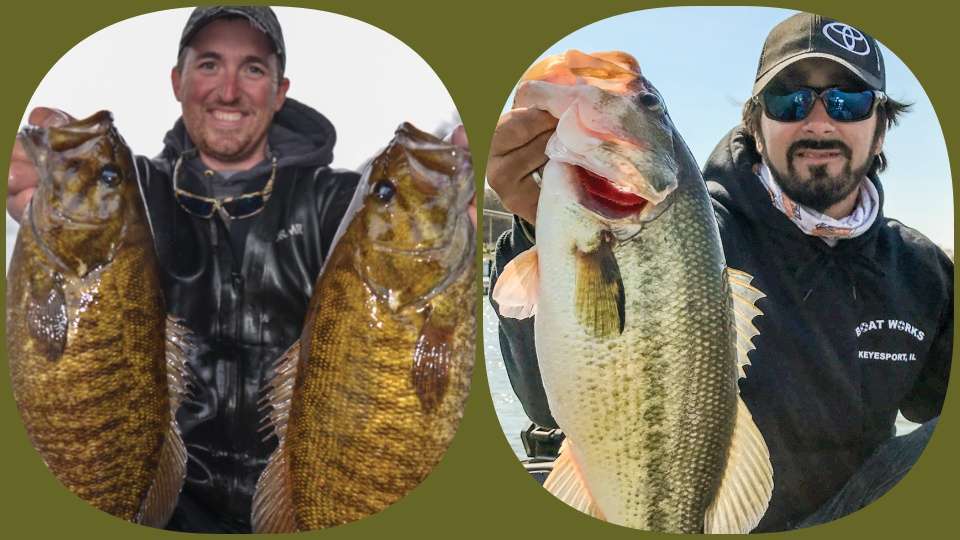
Catching numbers of big fish is a true talent. Here’s how some of the top pros locate and target the biggest fish in a given system.
Editor’s note: Land of Giants Fall | Winter | Summer | Spring
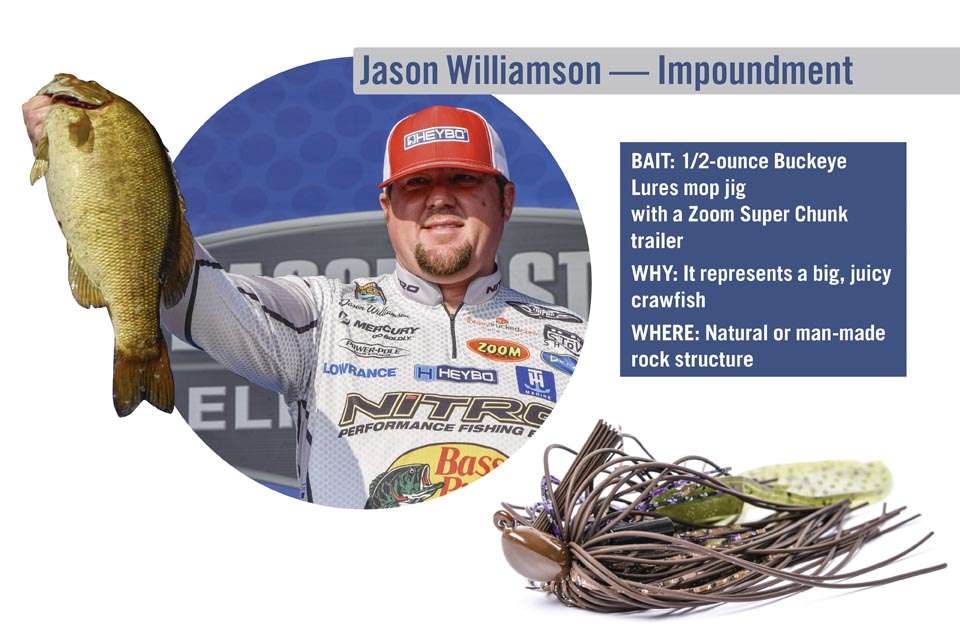
Jason Williamson
Knowing the fish’s seasonal preference for crawfish, Williamson puts his faith in a hefty 1/2-ounce Buckeye Lures mop jig. Complementing the jig’s living rubber skirt with a Zoom Super Chunk trailer creates the substantial profile that entices big fish.
“If we have clear water, I choose the natural colors — brown or green pumpkin — but as it gets more stained, you go to your darker colors, like black and blue,” Williamson said.
During the cold months, Williamson’s usually fishing in 12 to 25 feet and targeting natural or man-made rock, which keeps him in the right neighborhoods for crawfish impersonations. The rocks are typically some of the warmest habitat that crawfish and bass can find this time of year, so that’s where the action centers.
Fishing his jig on a 7-foot, 7-inch heavy J-Will series Taipan rod and 20-pound Gamma fluorocarbon, Williamson favors a presentation that sounds like the formula for a good brisket: low and slow. Lethargic fish rarely chase, so moving his jig at a glacial pace gives that bulky skirt plenty of time to work its wiles on fish looking for an easy belly-filler.
“Crawdads are one of their main forage items this time of year, and nothing can beat a really big jig presented really slowly,” Williamson said.
The air’s chilly, you’re looking at your breath, and those fish aren’t loving the lower water temps, but that doesn’t mean you have to settle for dismal days and dinky catches. Big fish may be few and far between, but follow the advice from these Bassmaster Elite Series pros and you’ll enjoy more shots at legitimate winter space heaters.
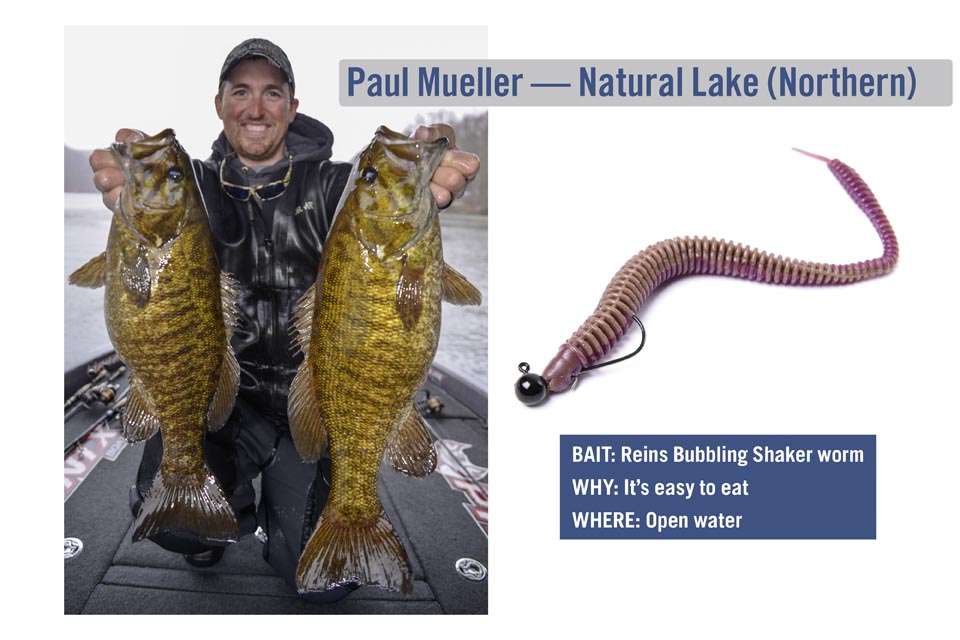
Paul Mueller
When winter finds his local lakes topped with ice, this Connecticut pro targets whopper bass with a technique he’s also successfully employed in open-water scenarios. Mueller rigs a Reins Bubbling Shaker worm on a 1/8-ounce tungsten Tackle Supply Depot Micro Finesse Ball Out Jig and wiggles it ever so slightly with a taunting display that even a shivering micropterus can’t resist.
“Most of the year, you want to use a big bait to catch a big fish, but when I’m dealing with temperature extremes in the dead of winter, I go the complete opposite,” Mueller said. “I use this bait a lot for panfish, but it’s deadly on bass when the water is cold. If I can mark a fish, I can catch it, no matter where I’m fishing.”
Constantly shaking his rod tip, but not moving his bait any significant distance, Mueller wants that tiny worm to float through the water just above the fish he’s marking. Killing the bait and letting it fall in front of the fish is usually the deal closer.
He employs Panoptix LiveScope’s down to read the fish’s mood and increase or decrease bait motion as needed to trigger the bite. Mueller also stresses the importance of light line for getting a diminutive bait down to the strike zone. He likes 5-pound Gamma Touch fluorocarbon for its minimal water resistance and fish-fighting strength.
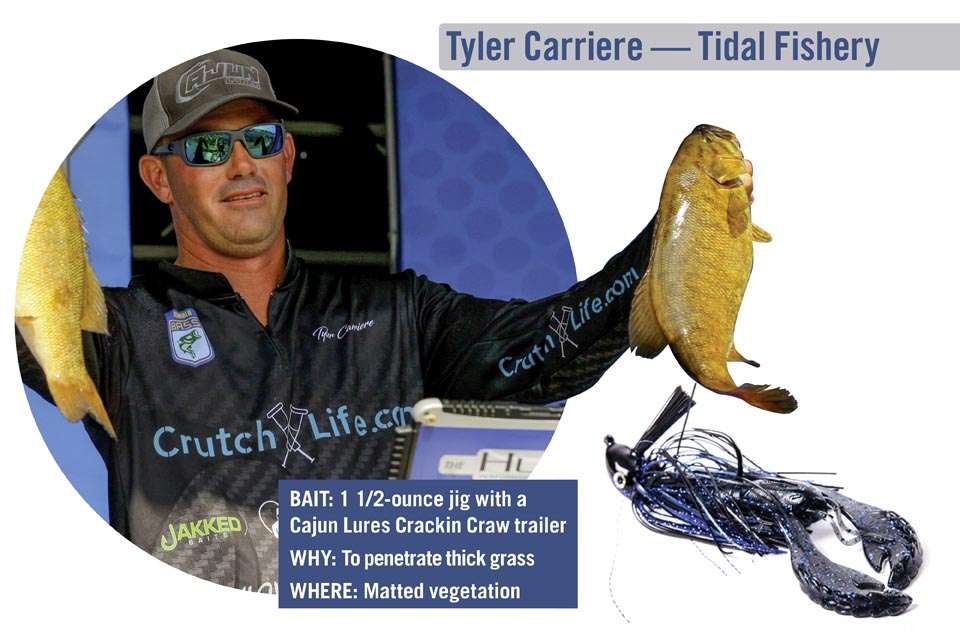
Tyler Carriere
When this Youngsville, La., pro needs a big bite in the coldest months of the year, he goes punching — but not like during the summer months. From Bayou Black to the Venice marsh, Carriere targets the densest vegetation he can find — be it alligator grass or any surviving water hyacinths — and sends a 1 1/2-ounce Jakked Baits Drunkk Punch Jig with a Cajun Lures Crackin Craw trailer.
“You just find the thickest vegetation you can find — as long as it has water under it,” Carriere said of the heat-holding habitat favored by tidal fish.
The biggest difference between his warm-season punching and this cold-season, giant-snatching technique is the bait’s fall. When he’s layered in warm clothing, that jig has a short trip through the cover.
“I’ll punch the bait through, let it fall a couple of inches, and I stop it,” Carriere said. “I’ll shake it a little bit and then just let it sit. It seems like when I shake it again after a couple of seconds, that’s when they hit it.
“In the summertime, they usually hit it on the way down, but in the cold weather, they don’t want it on the fall. I think the fish sit under those mats and pick off crawfish and the worms that we get on the hyacinth.”
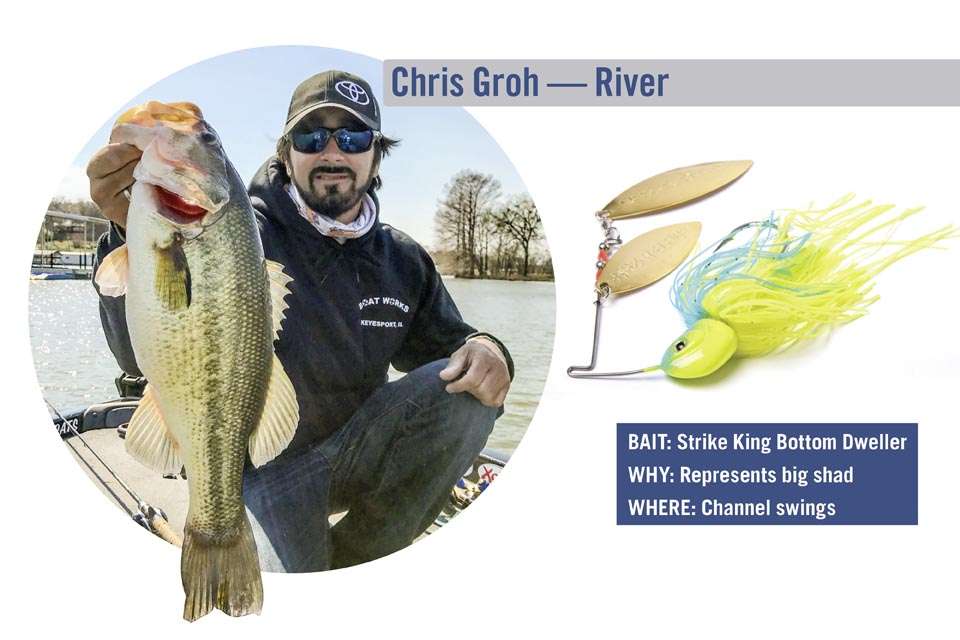
Chris Groh
Although he’d need an auger to reach most of his home state’s bass, this Illinois pro knows exactly where to find giants on flowing rivers anywhere he goes: channel swings. Key locations with proximity to both wintering spots and prespawn migration routes, channel swings gather the big ones, so Groh hits them with a flashy presentation.
“I’m going to target these fish with a big spinnerbait — a 3/4- to a 1 1/4-ounce Strike King Bottom Dweller — and dress it with a swimbait,” he said. “Whether that channel swing has a rock or some shell on it, I like to keep in contact with the bottom.
“The big spinnerbait looks like a gizzard shad rolling around down there. You’re trying to trigger wintering fish, and we all know that largemouth in this situation are a little lazy. This is a good bait to get one that just wants to chew on something that fell through the bait school.”
Groh said the Bottom Dweller’s compact form, anti-roll head design and small Raz-R-Blade thin-cut willowleaf blades keep the bait in that deep strike zone. Fishing the bait almost like a jig, Groh rumbles his spinnerbait across the structure where he expects to find winter-weary bass belly-down to the bottom.
Notably, Groh uses the more limber Xcite Shadnasty when the fish are active, while the Reaction Innovations Skinny Dipper works best for lethargic fish. With either, he rigs a small trailer hook to snare the ones that just slap at the bait.
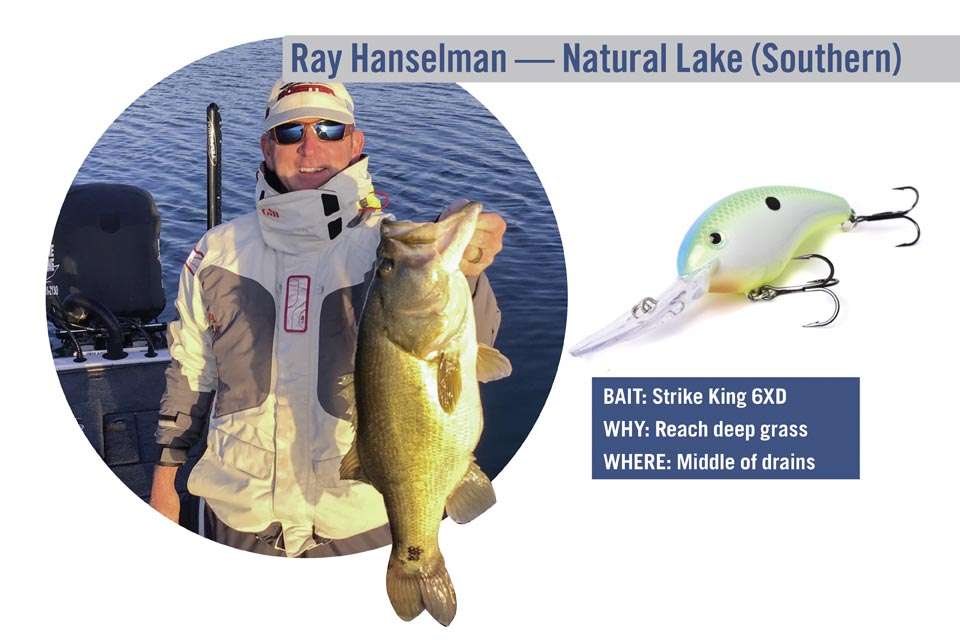
Ray Hanselman
When Southern bass — particularly stocked and home-state Florida-strain largemouth — begin their prespawn staging, Hanselman takes his giant search right to the grass. Specifically, he’s going to target the hydrilla lining the bottoms of creek channels leading into spawning creeks.
On lakes like Texas powerhouse Amistad, where grass might grow as deep as 18 to 22 feet, Hanselman cranks these carpeted lanes with a Strike King 5XD or 6XD or slow rolls a big spinnerbait. For shallower scenarios, he likes a Strike King 4.0 squarebill or a swimbait like the Strike King 4.75-inch Rage Swimmer. He’ll rig the latter on a 3/8- to 1/2-ounce jighead for low grass growth, but if the lawn’s dense and tall, he goes with a weedless weighted swimbait hook.
“I’ll start on the outside edge of the grass and work right into the center of the drain,” he said. “I’ll try to cover as many of those spots as I can. Typically, the bigger females will be on the high spots in the center of that channel. Sometimes, they’ll be on a channel swing, but if it’s just a drain, they’ll be dead center in the thickest grass.”
Ripping snagged crankbaits from entangling grass will trigger bites, but with the swimbait, Hanselman suggests a more measured tugging. This lets the bait grind through the cover with a noisy display that attracts the big girls’ attention.
Originally published in Bassmaster Magazine 2019.





